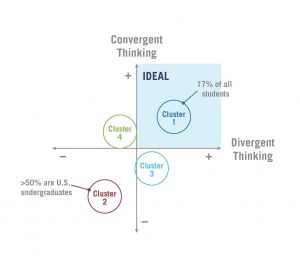by Dave Meaney and Dani Bassett

One can easily see that many of the world’s greatest challenges — producing enough food for the world population, providing each person with a set of fundamental human rights, or creating a sustainable environmental footprint as our societies move forward — must tap into two uniquely human traits: creativity and curiosity. In the fields of science and engineering, one can look at history and easily find creative and curious pioneers who ranged from Leonardo de Vinci (pioneered the field of human physiology), Grace Hopper (invented computer compilers), and Sir James Dyson (brought elegance to common household tools – the vacuum cleaner, the fan, the hand dryer, and the hair dryer).

Although we can look around and identify creative people, a natural question would be: What events in these individuals’ lives led to this creativity? We may see people around us who are creative and curious, but we often simply shrug and say ,“Wow, pretty ingenious person there.” Maybe we even think of this with a bit of yearning: “Boy, I wish I could think of things like that.” We often make the observation and get back to our daily lives, accepting that creative people are born or “just happen.” In other words, we are either struck by lightning, or we are not. Nothing could be further from the truth.

Creative and curious people are not genetically wired differently than others. Curiosity and creativity are not rare skills conferred by serendipity. Instead, creative and curious people have benefited from mentors who pushed them to ask “Why?” at the right time in their lives: perhaps being in the right science class with the right teacher in middle school or reading a novel that made them imagine a world they could not see.
What does all of this have to do with engineering? Well, some research suggests that many U.S. engineering undergraduates are weaker than their international counterparts in divergent and convergent thinking, which are two critical ingredients for creativity. These two thinking modalities may be propelled by different sorts of curiosity. Assessment tests for creative thinking traits often measure the ability to synthesize ideas, observations, and other information to make something new. From many possibilities, only one emerges as the ideal solution. This process is generally referred to as convergent thinking. A second creativity trait is the raw ability to generate ideas, given a particular problem. For example, one could be asked to generate as many possible uses of a brick that one can think of, and the resulting ideas are scored — both in terms of the number of ideas generated and the distinctiveness of each idea separately. This assessment, known as the alternative use test, measures divergent thinking. Ideally, engineers would have high ability in both divergent and convergent thinking, which would mean that they could both think of many possible solutions and pick the best among them. However, one study performed almost a decade ago showed that half of the engineering undergraduates in the U.S. showed deficiencies in both convergent and divergent thinking — troubling, to say the least.

However, all is not lost. Many changes have occurred over the last decade for engineering education in the U.S. We embraced the laboratory as a platform for problem-based learning, which cultivates the ideation phase of creativity and the convergence to a solution. We have also ‘tipped’ and ‘flipped’ the classroom to introduce more methods of open-ended problems as teaching tools, again using this change to reinforce that there are many ways and, rarely, one best way to solve a particular problem.
Yet with all of these very positive changes, we still don’t have a good road map for how ideas form in the mind, how we trade off one idea versus another, and how we decide which is the best idea. Our tools for creativity are based on countless efforts to try different methods, measure whether they have an effect, and take the most successful empirical methods and transform them into practice. Until recently, we had no idea what was going on in the mind during the creative process.
Fortunately, we now have ways to both interrogate and model how the mind works when we think and create. Inspired by the principle that blood flow will increase to areas of the brain with high neural activity (side note: the brain is a remarkable energy hog for the body, representing less than 3% of body mass but consuming nearly 20% of its energy resources), researchers are measuring how flow to different areas of the brain change when people are asked to perform specific tasks. Early work showed these beautiful, color-coded images of how one task would increase blood flow to one area, while another task would increase blood flow to a different area.
Patterns of connectivity in the brain can be represented as
dynamic networks, which change in their configuration as
humans change mental states or cognitive processes while
performing a task.
However, scientists began to realize, that instead of looking at one pattern of brain activation at one time, we needed to study how the pattern changed over time. Analyzing these changes over time allowed us to estimate the brain areas that activated simultaneously with another during a mental task. If they activated together frequently, we assumed that they would have a functional connectivity between them. Simply put, areas that fire together are wired together, metaphorically speaking. Very quickly, we saw maps of the brain’s own functional network emerge when volunteers would work on math problems, navigate a maze, and even when they were asked to just daydream.
Where does this lead us? Well, we stand on the cusp of learning and predicting the coordinated steps that our mind takes when we imagine different ideas and pick one as ‘the best.’ Not only can we map this process in real time, but we can also develop new theories about how to ‘steer’ from one brain network state to another. We can also apply this new knowledge to individuals on a case-by-case basis, rather than relying on the one-size-fits-all approach that is the current and common practice in cultivating divergent and convergent thinking. In practice, this means that we would move away from prescribing the same creativity training exercise for everyone — with a large variation in the results — to a far more customized, efficient cognitive exercise. In fact, we could directly test the possibility that some of these exercises work for some people and not others because of an individual’s brain wiring map. Science fiction? Nope, just modern day bioengineering at work.
David F. Meaney, Professor of Bioengineering and Neurosurgery
Danielle S. Bassett, Associate Professor of Bioengineering and Electrical and Systems Engineering
